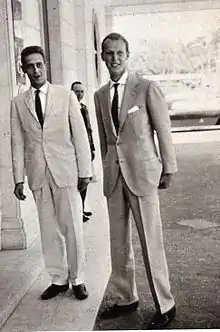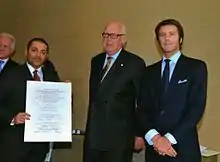Vittorio Emanuele, Prince of Naples
Prince Vittorio Emanuele of Savoy, Prince of Naples[1] (Vittorio Emanuele Alberto Carlo Teodoro Umberto Bonifacio Amedeo Damiano Bernardino Gennaro Maria di Savoia;[2][3] born 12 February 1937) is the only son of Umberto II, the last King of Italy, and his wife Marie-José of Belgium. Vittorio Emanuele also uses the title Duke of Savoy and claims the headship of the House of Savoy. These claims were disputed by supporters of his third cousin, Prince Aimone, 6th Duke of Aosta.
| Vittorio Emanuele | |||||
|---|---|---|---|---|---|
| Prince of Naples Duke of Savoy | |||||
.jpg.webp) | |||||
| Head of the House of Savoy (disputed) | |||||
| Pretence | 18 March 1983 – present | ||||
| Predecessor | King Umberto II | ||||
| Heir apparent | Prince Emanuele Filiberto | ||||
| Born | 12 February 1937 Naples, Kingdom of Italy | ||||
| Spouse | |||||
| Issue | Emanuele Filiberto, Prince of Venice | ||||
| |||||
| House | Savoy | ||||
| Father | Umberto II of Italy | ||||
| Mother | Marie-José of Belgium | ||||
He has lived for most of his life in exile, following the constitutional referendum of 1946 which affirmed the abolition of the monarchy and the creation of the Italian Republic. On several occasions, he has been the centre of controversy in Italy and abroad due to a series of incidents, including remarks that were seen by some as antisemitic. He was revealed to be a member of Propaganda Due (P2), the state within a state responsible for high-level corruption and political manipulation.[4] In France he was tried on a murder charge, of which he was cleared of unlawful killing but convicted of a firearms offence. On 16 June 2006, following an investigation started by John Woodcock of the Public Prosecutor's Office in Potenza, Italy, Vittorio Emanuele was arrested on charges of criminal association, racketeering, conspiracy, corruption and exploitation of prostitution.[5] A trial on these charges began in Potenza, Italy, on 21 December 2009. Vittorio Emanuele di Savoia was acquitted of all charges in 2007 and 2010.[6][7]
Early life and family
Vittorio Emanuele was born 12 February 1937 in Naples to Umberto, Prince of Piedmont, who would later become the last King of Italy as Umberto II, and Princess Marie-José of Belgium.[2][3] When Umberto II left Italy after the monarchy was abolished by the 1946 Italian institutional referendum, the remaining members of the House of Savoy lived in exile, mostly in Switzerland and on the Portuguese Riviera, though the former king Victor Emmanuel III, grandfather to Vittorio Emanuele, lived in Egypt until his death in 1947. Following the separation of the exiled ex-King and ex-Queen, Vittorio Emanuele lived with his mother in an estate in Merlinge, Switzerland. Vittorio Emanuele and his family currently reside in Geneva.
After an eleven-year relationship, Vittorio Emanuele married Swiss biscuit heiress and world-ranked water skier Marina Doria in Tehran, Iran, on 7 October 1971,[2] at the occasion of the 2,500-year celebration of the Persian Empire. Coincidentally, Vittorio Emanuele and his wife Marina share a birthday (12 February) but Vittorio Emanuele is two years younger than Marina (she was born in 1935).
Vittorio Emanuele has worked as a banker and an aircraft salesman, and then an arms dealer.[8]
Vittorio Emanuele has one son, Prince Emanuele Filiberto of Savoy, Prince of Venice, born on 22 June 1972,[2][3] who has two daughters.
Duke of Savoy
On 7 July 2006 Vittorio Emanuele's kinsman and dynastic rival, Amedeo, 5th Duke of Aosta declared himself to be the head of the House of Savoy and Duke of Savoy, claiming that Vittorio Emanuele had lost his dynastic rights when he married without the permission of Umberto II in 1971. Amedeo has received the support of the President of the Council of the Senators of the Kingdom Aldo Alessandro Mola.
Vittorio Emanuele and his son have applied for a judicial injunction to forbid Amedeo from using the title "Duke of Savoy". In February 2010, the court of Arezzo[9] ruled that the Duke of Aosta and his son must pay damages totalling €50,000 to their cousins and cease using the surname Savoy instead of Savoy-Aosta.[10] However, the verdict was overturned on appeal, with the court of second resort allowing Amedeo the use of the short surname, in the form of di Savoia, and additionally revoking the financial penalty originally imposed on him.
Dynastic Orders of Savoy
Vittorio Emanuele is the Grandmaster of the Dynastic Orders of Savoy which consist of:[11]
_crowned.svg.png.webp) House of Savoy: Royal Supreme Order of the Most Holy Annunciation
House of Savoy: Royal Supreme Order of the Most Holy Annunciation_crowned.svg.png.webp) House of Savoy: Royal Order of Saints Maurice and Lazarus
House of Savoy: Royal Order of Saints Maurice and Lazarus_crowned.svg.png.webp) House of Savoy: Royal Order of the Crown
House of Savoy: Royal Order of the Crown_crowned.svg.png.webp) House of Savoy: Royal Civil Order of Savoy
House of Savoy: Royal Civil Order of Savoy_crowned.svg.png.webp) House of Savoy: Royal Military Order of Savoy
House of Savoy: Royal Military Order of Savoy
Vittorio assumed the title of Grandmaster in 1983 when his father Umberto II of Italy passed away.
Exile from and return to Italy
Reasons for exile

In line with certain other countries that were formerly monarchies (such as France or Romania), the Italian Constitution required all male members of the House of Savoy to leave Italy and barred them from ever returning to Italian soil again. This was enacted as a "temporary disposition" enacted when the constitution was promulgated in 1948. The constitution also forbade any amendment that would change the republican form of government, effectively foreclosing any effort to restore the monarchy short of adopting a new constitution.
Requests for return
Vittorio Emanuele lobbied the Parliament of Italy over the years in which the law prohibiting his return was in force, to be allowed to return to his homeland after 56 years in exile. In 1999, he filed a case at the European Court of Human Rights, in which the Prince charged that his lengthy exile violated his human rights. In September 2001, the court decided to hold a hearing on the case at a date later to be fixed.[12]
In order to achieve a return to his homeland, he renounced any claim to the defunct throne and to Italy's crown jewels. He publicly assured the Italian government that the nation and the crown properties, confiscated by the State in 1946, "are no longer ours", referring to the House of Savoy. "For that matter we have no claim on the Crown jewels", he said. "We have nothing in Italy and we are not asking for anything". Vittorio Emanuele also dropped his case at the European Court of Human Rights. In February 2002, Vittorio Emanuele and his son Emanuele Filiberto wrote a signed letter, published through a law firm, in which they formally expressed their loyalty to the Constitution of Italy.[13]
Return to Italy
On 23 October 2002, the provision in the constitution that barred male members of the former royal house from returning to Italy was repealed. As part of a deal with the government, Vittorio Emanuele signed an agreement renouncing all claims to the defunct throne and recognizing the Republic as the only lawful government of Italy. Vittorio Emanuele was permitted to re-enter the country on 10 November 2002. On 23 December 2002, he made his first trip home in over half a century. On the one-day visit he, his wife and his son had a 20-minute audience with Pope John Paul II at the Vatican.[14]
Upon their first visit in 2003 to Naples, where Vittorio Emanuele was born, and from where his family sailed into exile in 1946, the reception of the Savoys was mixed; most people were indifferent to them, some hostile, a few supportive. The media reported that many in Naples were not happy to see the return of the family, when hundreds of noisy demonstrators chanted negative slogans as they progressed through the city.[8] Demonstrations were staged by two traditionally opposing factions: anti-monarchists on one hand, and supporters of the House of Bourbon-Two Sicilies, the royal house deposed when Italy was united in 1861 under the House of Savoy.[15]

Controversies
Unilateral declaration of kingship (1969)
Vittorio Emanuele unilaterally declared himself King of Italy on 15 December 1969.[16][17] He argued that by agreeing to submit to a referendum on his place as head of state, his father had thereby abdicated. Vittorio Emanuele took this action after his father allegedly called for Amedeo, 5th Duke of Aosta to visit him in Portugal to name him his heir.[18] Under his self-assumed powers as King of Italy, Vittorio Emanuele conferred the title of Duchess of Sant'Anna di Valdieri on his then-fiancée, Marina Doria.[19]
Dirk Hamer's death (1978–2015)
On the night of 17 August or the morning of 18 August 1978, on the island of Cavallo (which lies off the south coast of Corsica), Vittorio Emanuele discovered his yacht's rubber dinghy had been taken and attached to another nearby yacht. Arming himself with a rifle, he attempted to board the vessel. He shot at a passenger he had awakened; the shot missed the passenger but mortally wounded Dirk Hamer (the 19-year-old son of Ryke Geerd Hamer), a passenger sleeping on the deck of another adjacent yacht. The prince admitted civil liability for the death in a letter dated 28 August 1978.[20] Dirk Hamer died of his wounds on 7 December 1978, and Vittorio Emanuele was arrested.
On 11 October 1989, Vittorio Emanuele was indicted on charges of inflicting lethal injury and possession of a dangerous weapon. However, on 18 November 1991, after thirteen years of legal proceedings, the Paris Assize Court acquitted him of the fatal wounding and unintentional homicide charges, finding him guilty only of unauthorised possession of an M1 carbine.[20] He received a six-month suspended prison sentence.[21]
When incarcerated in June 2006, on unconnected charges of corruption (see below, Arrest and imprisonment), Vittorio Emanuele was recorded admitting that "I was in the wrong, [...] but I must say I fooled them [the French judges]",[22] leading to a call from Dirk Hamer's sister Birgit for Vittorio Emanuele to be retried in Italy for killing her brother.[23]
Birgit Hamer undertook a long legal fight to obtain the full video. She stated: "What for us is a confession is a boast for him: he laughs about the fact that he killed a boy."[24] The story of the video was broken by aristocratic journalist Beatrice Borromeo,[25] who also wrote the preface for a book on the murder, Delitto senza castigo by Birgit Hamer. Vittorio Emanuele sued the newspaper for defamation, claiming the video had been manipulated. In 2015, a court judgement ruled in favour of the newspaper.[26] On Twitter Borromeo posted: "Vincere una causa è sempre piacevole, ma contro Vittorio Emanuele di Savoia la goduria è doppia!" ("Winning a case is always nice, but against Victor Emmanuel of Savoy the pleasure is double"),[27] which resulted in a spat on Twitter with his son Emanuele Filiberto.[26]
Allegations of antisemitism (2003)
Vittorio Emanuele also said in 2003 that the antisemitic laws passed under Mussolini's regime were "not that terrible".[28][29] In response, the president of the Union of Italian Jewish Communities, Amos Luzzatto, stated that "I'm not saying it was he who signed the racial laws in 1938. But, as a Savoy heir, Victor Emmanuel has never distanced himself from them," in an interview with Il Corriere della Sera newspaper.[30]
On 27 January 2005, in a letter published by Il Corriere della Sera, Vittorio Emanuele issued an apology to Italy's Jewish population, asking forgiveness from the Italian Jewish community, and declaring that it was an error for the Italian Royal Family to have signed the racial laws of 1938.[31]
Arrest and imprisonment (2006)
On 16 June 2006, Vittorio Emanuele was arrested in Varenna and imprisoned in Potenza on charges of corruption and recruitment of prostitutes for clients of the Casinò di Campione of Campione d'Italia.[32][33][34]
The enquiry was conducted by Italian magistrate John Woodcock, of British ancestry, famous for other VIPs' arrests.[35][36][37]
After several days, Vittorio Emanuele was released and placed under house arrest instead. He was released from house arrest on 20 July 2006, but had to stay within the borders of Italy. Vittorio Emanuele was acquitted of all charges in the years 2007 and 2010.[6]
La Repubblica reported in 2006 that Emanuele Filiberto had distanced himself from his father.[38]
Seeking compensation from Italy (2007)
In 2007, Vittorio Emanuele and his son, Emanuele Filiberto, requested formally that the state pay financial damages of €260 million, and initiate full restitution of all properties and belongings that had been confiscated from the royal house after the abolition of the monarchy. The financial damages claim is based on having suffered moral injustice during the exile. The Italian government has rejected the request and, in response, indicated that it may seek damages for historic grievances.[39]
Succession
In June of 2023, his son Emanuele Filiberto, Prince of Venice announced his intention to abdicate his claim to the throne in favour of his daughter, Princess Vittoria of Savoy, when he feels she is ready to succeed. Until he formally does so he remains as his father's heir. [40]
Honours
| Styles of Prince Vittorio Emanuele | |
|---|---|
 | |
| Reference style | His Royal Highness |
| Spoken style | Your Royal Highness |
National dynastic honours
_crowned.svg.png.webp) House of Savoy: Grand Master of the Royal Supreme Order of the Most Holy Annunciation[41][42][43][44]
House of Savoy: Grand Master of the Royal Supreme Order of the Most Holy Annunciation[41][42][43][44]_crowned.svg.png.webp) House of Savoy: Grand Master of the Royal Order of Saints Maurice and Lazarus[45][46]
House of Savoy: Grand Master of the Royal Order of Saints Maurice and Lazarus[45][46]_crowned.svg.png.webp) House of Savoy: Grand Master of the Royal Order of the Crown[47][48][49]
House of Savoy: Grand Master of the Royal Order of the Crown[47][48][49]_crowned.svg.png.webp) House of Savoy: Grand Master of the Royal Civil Order of Savoy[50][51][52]
House of Savoy: Grand Master of the Royal Civil Order of Savoy[50][51][52]_crowned.svg.png.webp) House of Savoy: Grand Master of the Royal Military Order of Savoy[50]
House of Savoy: Grand Master of the Royal Military Order of Savoy[50]_crowned.svg.png.webp) House of Savoy: Grand Master of the Royal Order of Merit of Savoy[53]
House of Savoy: Grand Master of the Royal Order of Merit of Savoy[53]
National honours
.svg.png.webp) Sovereign Military Order of Malta: Bailiff Knight Grand Cross of Justice of the Sovereign Military Order of Malta, Special Class[54][55]
Sovereign Military Order of Malta: Bailiff Knight Grand Cross of Justice of the Sovereign Military Order of Malta, Special Class[54][55].svg.png.webp) Two Sicilian Royal Family: Bailiff Knight Grand Cross with Collar of Justice of the Two Sicilian Royal Sacred Military Constantinian Order of Saint George[56]
Two Sicilian Royal Family: Bailiff Knight Grand Cross with Collar of Justice of the Two Sicilian Royal Sacred Military Constantinian Order of Saint George[56]
Foreign honours
.svg.png.webp) Greek Royal Family: Knight Grand Cross of the Royal Order of the Redeemer[57]
Greek Royal Family: Knight Grand Cross of the Royal Order of the Redeemer[57] Monaco: Knight Grand Cross of the Order of Saint-Charles[58]
Monaco: Knight Grand Cross of the Order of Saint-Charles[58].svg.png.webp) Montenegrin Royal Family: Knight of the Order of Petrović Njegoš
Montenegrin Royal Family: Knight of the Order of Petrović Njegoš.svg.png.webp) Montenegrin Royal Family: Knight Grand Cross of the Royal Order of Prince Danilo I
Montenegrin Royal Family: Knight Grand Cross of the Royal Order of Prince Danilo I.svg.png.webp) Montenegrin Royal Family: Knight of the Order of Saint Peter of Cetinje
Montenegrin Royal Family: Knight of the Order of Saint Peter of Cetinje Empire of Iran: Recipient of the Commemorative Medal of the 2,500-year celebration of the Persian Empire[59][60]
Empire of Iran: Recipient of the Commemorative Medal of the 2,500-year celebration of the Persian Empire[59][60]
Ancestry
| Ancestors of Vittorio Emanuele, Prince of Naples | |||||||||||||||||||||||||||||||||||||||||||||||||||||||||||||||||||||||||||||||||||||||||||||||||||||||||||||||||||||||||||||||||||||||||||||||||||||||||||||||||||||||||||||||||||||||||||||||||||||||||||||||||||||||||||||||||||||||||||||||||||||||||||||||||||||||||||||||||||||||||
|---|---|---|---|---|---|---|---|---|---|---|---|---|---|---|---|---|---|---|---|---|---|---|---|---|---|---|---|---|---|---|---|---|---|---|---|---|---|---|---|---|---|---|---|---|---|---|---|---|---|---|---|---|---|---|---|---|---|---|---|---|---|---|---|---|---|---|---|---|---|---|---|---|---|---|---|---|---|---|---|---|---|---|---|---|---|---|---|---|---|---|---|---|---|---|---|---|---|---|---|---|---|---|---|---|---|---|---|---|---|---|---|---|---|---|---|---|---|---|---|---|---|---|---|---|---|---|---|---|---|---|---|---|---|---|---|---|---|---|---|---|---|---|---|---|---|---|---|---|---|---|---|---|---|---|---|---|---|---|---|---|---|---|---|---|---|---|---|---|---|---|---|---|---|---|---|---|---|---|---|---|---|---|---|---|---|---|---|---|---|---|---|---|---|---|---|---|---|---|---|---|---|---|---|---|---|---|---|---|---|---|---|---|---|---|---|---|---|---|---|---|---|---|---|---|---|---|---|---|---|---|---|---|---|---|---|---|---|---|---|---|---|---|---|---|---|---|---|---|---|---|---|---|---|---|---|---|---|---|---|---|---|---|---|---|---|---|---|---|---|---|---|---|---|---|---|---|---|---|---|---|---|
| |||||||||||||||||||||||||||||||||||||||||||||||||||||||||||||||||||||||||||||||||||||||||||||||||||||||||||||||||||||||||||||||||||||||||||||||||||||||||||||||||||||||||||||||||||||||||||||||||||||||||||||||||||||||||||||||||||||||||||||||||||||||||||||||||||||||||||||||||||||||||
Patrilineal descent
Gallery
 Prince Vittorio Emanuele with his father, King Umberto II and his grandfather King Vittorio Emanuele III
Prince Vittorio Emanuele with his father, King Umberto II and his grandfather King Vittorio Emanuele III Prince Vittorio Emanuele with his father, King Umberto II
Prince Vittorio Emanuele with his father, King Umberto II Vittorio Emanuele in 1964
Vittorio Emanuele in 1964.jpg.webp) Vittorio Emanuele as Grandmaster of the Order of Saints Maurice and Lazarus
Vittorio Emanuele as Grandmaster of the Order of Saints Maurice and Lazarus Vittorio Emanuele and Marina Doria, Cape Canaveral, 16 July 1969 (Apollo 11)
Vittorio Emanuele and Marina Doria, Cape Canaveral, 16 July 1969 (Apollo 11)
References
- Titles associated with the former Italian royal family have not been legally recognised by the Italian government since Temporary Provision XIV was incorporated in the Constitution of Italy in 1946.
- Genealogisches Handbuch des Adels, Fürstliche Häuser XIV. "Haus Italien". C.A. Starke Verlag, 1997, pp. 33, 38–39. ISBN 3-7980-0814-0.
- Willis, Daniel, The Descendants of Louis XIII, Clearfield Co., Inc., Baltimore, Maryland, 1999, p. 673. ISBN 0-8063-4942-5.
- Hooper, John (23 June 2006). "The fall of the house of Savoy". The Guardian. Retrieved 18 November 2015.
- Popham, Peter (17 June 2006). "Son of Italy's last king held over Mafia and prostitution claims". The Independent. Archived from the original on 2 November 2007. Retrieved 10 April 2008.
The son of Italy's last king, Prince Victor Emmanuel, has been arrested in the north Italian town of Lecco as part of an investigation into charges he was involved with the Sicilian Mafia and a prostitution racket.
- Savoiagate, Vittorio Emanuele assolto Archived 29 June 2018 at the Wayback Machine. Affaritaliani.it. Retrieved on 26 July 2015.
- "Videopoker, assolto Vittorio Emanuele". Corriere della Sera. 22 September 2010.
- Popham, Peter (22 June 2006). "The prince and the prostitutes". The Independent. Archived from the original on 11 December 2007. Retrieved 10 April 2008.
Selling helicopters to his high and mighty friends was one of the prince's successful projects, from which he went on to become an arms dealer.
- Meylan, Vincent (21 May 2008). "Duc d'Aoste ou Duc de Savoie?". Point de Vue: 79.
- Squires, Nick (18 February 2010). "Italian aristocrat cousins fight over defunct throne". The Telegraph. Rome. Retrieved 23 July 2017.
- "The Dynastic Orders – Ordini Dinastici della Real Casa di Savoia". Retrieved 17 October 2022.
- Victor Emmanuel de Savoie v. Italy, 656 to hold a hearing on the merits of the admissible complaints on a date to be fixed subsequently (European Court of Human Rights 21 September 2001).
- "Vittorio Emanuele di Savoia: "Fedeltà alla Costituzione"". La Repubblica (in Italian). 2 February 2002. Retrieved 10 April 2008.
- Willan, Philip (24 December 2002). "Exiled Italian royals go home". The Guardian. Retrieved 10 April 2008.
- Johnston, Bruce (8 January 2008). "Italy's exiled royal family shunned as they return". Telegraph.co.uk. Archived from the original on 18 November 2004. Retrieved 24 April 2008.
- Royal Decree No. 1. realcasadisavoia.it
- Pro Veritate analysis n.1 by Prof. Edoardo Adami. realcasadisavoia.it
- Gigi Speroni, Umberto II, Milan, Riscoli Libri
- Pro Veritate analysis n.2 by Prof. Edoardo Adami. realcasadisavoia.it
- HAMER v. FRANCE – 19953/92 [1996] ECHR 30 (7 August 1996). Worldlii.org. Retrieved on 26 July 2015.
- Summary of trial proceedings concerned the killing of Dirk Hamer. sim.law.uu.nl
- "Vittorio Emanuele, cimici in cella "Ho fregato i giudici francesi" - cronaca - Repubblica.it". www.repubblica.it.
- Prince's braggadocio spurs call for justice. galleonpoint.com. 12 September 2006
- Follain, John (27 February 2011). "Prince admits killing on video". The Sunday Times. Archived from the original on 10 March 2016.
- "Il video che incastra Savoia". Il Fatto Quotidiano (in Italian). 24 February 2011. Retrieved 23 March 2023.
- "Beatrice Borromeo, el azote de los Saboya". hola.com (in Spanish). 10 March 2015. Archived from the original on 26 July 2016.
- "Beatrice Borromeo on Twitter". Twitter. Retrieved 10 March 2016.
- "Italy's Jews wait for royal apology" (The Observer (UK), 18 May 2003). "It was a rocky start for what was intended as a romantic trip down memory lane for Italy's exiled royal family, the Savoys, who returned to Rome last week to meet government officials, only to be greeted by angry Italian Jews still waiting for an apology for the royals' antisemitic leanings during the Second World War. Some five years ago, Victor Emmanuel made headlines when he said in an interview that the race laws were 'not so bad'".
- Leyland, Joanne (18 June 2006) Former King of Italy's Son Arrested . The Royalist
- Tom Gross (18 June 2003). "An Englishman in Auschwitz and other Holocaust articles".
- "Stephen Roth Institute: Antisemitism And Racism". antisemitism.tau.ac.il. 2005. Archived from the original on 18 May 2007.
- Arrest and jail. Corriere.it. Retrieved on 26 July 2015.
- Arrested Italy prince goes from palace to jail. MSNBC (17 June 2006). Retrieved on 26 July 2015.
- The Prince and the prostitutes. Findarticles.com. Retrieved on 26 July 2015.
- VIP arrests by Woodstock. Corriere.it. June 2006.
- «Mandami su il pacco con la ragazza» – La Stampa Archived 1 July 2006 at the Wayback Machine. Lastampa.it (17 June 2006). Retrieved on 26 July 2015.
- Vittorio Emanuele, cimici in cella "Ho fregato i giudici francesi" – cronaca. Repubblica.it (9 September 2006). Retrieved on 26 July 2015.
- Emanuele Filiberto si dissocia dal padre "Non condivido tutto quello che ha fatto" – cronaca. Repubblica.it. Retrieved on 26 July 2015.
- Stewart, Phil (21 November 2007). "Fallen savoy royals seek damages over Italy exile". Reuters.
- "19-year-old influencer could be Italian queen after prince gave up the throne". 7 June 2023.
- "Document about Vittorio Emmanuelle's sovereignty". Archived from the original on 3 October 2015.
- "Vittorio Emmanuelle wearing the Great Collar". Retrieved 14 July 2017.
- "Vittorio Emmanuel wearing the Badge as a Medal". Archived from the original on 3 October 2015. Retrieved 14 July 2017.
- "Royal Italy". Pinterest. Retrieved 14 July 2017.
- "Document about Vittorio Emmanuelle's sovereignty". Archived from the original on 3 October 2015.
- "Editorial & News Images: News Photography, Pictures, Awards, Events, Sports, Celebrity Photos – Getty Images". www.corbisimages.com. Retrieved 14 July 2017.
- "document about Vittorio Emmanuelle's sovereignty". Archived from the original on 25 January 2009. Retrieved 14 July 2017.
- "Xiao Wen Ju and Fei Fei Sun in 'Magic Lens',... – The St. Andrew Knot". The St. Andrew Knot. Retrieved 14 July 2017.
- "Layout 1" (PDF).
- Royal Website, document about Vittorio Emmanuelle's sovereignty of the Military and civil orders Archived 3 October 2015 at the Wayback Machine
- "wearing the star of the civil order at the bottom". Archived from the original on 25 November 2016. Retrieved 14 July 2017.
- "Vittorio Emmanuel confers the order". Retrieved 14 July 2017.
- "History". savoyfoundation-usa.org.
- "The St. Andrew Knot - Queen Maria José of Italy (Wearing the Musy". Archived from the original on 4 March 2016. Retrieved 24 May 2017.
- "- Pretenders to the Throne". www.nobility-association.com. Retrieved 23 March 2023.
- "The Constantinian Order's Relationship with the Savoy Dynasty of Italy – Sacred Military Constantinian Order of St. George". 4 October 2012. Archived from the original on 29 July 2017. Retrieved 14 July 2017.
- "Princess Maria Gabriella Of Savoy - FamousFix.com post". FamousFix.com.
- Nomination by Sovereign Ordonnance n° 15702 of 1 March 2003 Archived 3 March 2016 at the Wayback Machine (French)
- Badraie Archived 5 March 2016 at the Wayback Machine. Badraie. Retrieved on 26 July 2015.
- Celebraciones de Persépolis 1971 – VII. Casaimperialdeiran.blogspot.com.es. 19 May 2012.
Bibliography
- Hamer, Birgit (2011). Borromeo, Beatrice (ed.). Delitto senza castigo: la vera storia di Vittorio Emanuele di Savoia [Crime without Punishment: the True Story of Vittorio Emanuele di Savoia] (in Italian). Reggio Emilia: Aliberti. ISBN 978-88-7424-735-6.
.svg.png.webp)
.svg.png.webp)